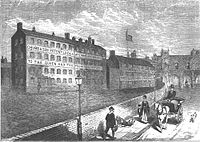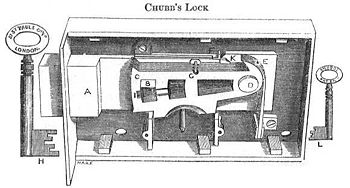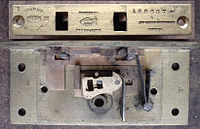- Chubb detector lock
-
A Chubb detector lock is a type of lever tumbler lock with an integral security feature which frustrates unauthorised access attempts and indicates to the lock's owner that it has been interfered with. When someone tries to pick the lock or to open it using the wrong key, the lock is designed to jam in a locked state until (depending on the lock) either a special regulator key or the original key is inserted. A person attempting to pick a detector lock after triggering the automatic jamming mechanism has the additional problem of resetting the detector mechanism. This introduces additional complexity into the task, thereby increasing the degree of lock-picking skill required to a level which very few people would have. The first detector lock was produced in 1818 by Jeremiah Chubb of Portsmouth, England, as the result of a Government competition to create an unpickable lock. It remained unpicked until the Great Exhibition of 1851.
Contents
Development
Jeremiah Chubb, who was working with his brother, Charles, as a ship's outfitter and ironmonger in Portsmouth, invented and patented his detector lock in 1818. In 1817, a burglary in Portsmouth Dockyard which had been carried out using false keys to gain entry prompted the British Government to announce a competition to produce a lock that could be opened only with its own key. Building on earlier work by Robert Barron and Joseph Bramah, Jeremiah developed a four-lever lock that when picked or opened with the wrong key would stop working until a special key was used to reset it. This security feature was known as a regulator, and was tripped when an individual lever was pushed past the position required to bring the lever in line to open the lock. As a result of this innovation, Jeremiah was able to claim the £100 reward offered by the Government.
 The Chubb works in Railway Street, Wolverhampton (1870)
The Chubb works in Railway Street, Wolverhampton (1870)
A convict aboard one of the prison hulks in Portsmouth Docks was given the Chubb lock with a promise of a free pardon from the Government and £100 from Jeremiah if he could pick the lock. The convict, who was a locksmith by trade and had successfully picked every lock he had been presented with, was confident he could do the same with the detector lock. After two or three months of trying he was forced to admit defeat.
Manufacture and improvements
In 1820, Jeremiah joined his brother Charles in starting their own lock company, Chubb. They moved from Portsmouth to Wolverhampton, which was the lockmaking capital of Great Britain, and opened a factory in Temple Street. In 1836 they moved to St James' Square in the same town. A further move to the site of the old Workhouse in Railway Street followed in 1838. The Chubb lock reportedly became popular as a result of the interest generated when George IV accidentally sat on a Chubb lock that still had the key inserted.[1]
A number of improvements were made to the original design over the years but the basic principle behind its construction remained unchanged. In 1824, Charles patented an improved design that no longer required a special regulator key to reset the lock. The original lock used four levers, but by 1847 work by Jeremiah, Charles, his son John and others resulted in a six-lever version. A later innovation was the "curtain", a disc that allowed the key to pass but narrowed the field of view, hiding the levers from anybody attempting to pick the lock. Eventually, Chubb began to manufacture brass padlocks incorporating the "detector" mechanism.
Picking
Competition in the lock business was fierce and there were various challenges issued in an attempt to prove the superiority of one type of lock over another. Joseph Bramah exhibited one of his locks in the window of his shop and offered 200 guineas (£210) to anybody who could devise a method of picking it. In 1832, a Mr Hart, replying to a challenge by Chubb, failed to pick one of his detector locks. After a number of people tried and failed, the first person to pick the six-lever Chubb lock was Alfred Charles Hobbs, the inventor of the protector lock, during the Great Exhibition in 1851.
References
- Roper, C.A.; & Phillips, Bill (2001). The Complete Book of Locks and Locksmithing. McGraw-Hill Publishing. ISBN 0-07-137494-9.
- "Lock Making: Chubb & Son's Lock & Safe Co Ltd". Wolverhampton City Council. 2005. http://www.wolverhamptonhistory.org.uk/work/industry/lock_making2. Retrieved 16 November 2006.
- "Chubb History". Chubb. http://chubb.co.uk/utcfs/Templates/Pages/Template-54/0,8063,pageId%3D1583%26siteId%3D403,00.html. Retrieved 28 July 2009.
- "History of Locks". Encyclopaedia of Locks and Builders Hardware. Chubb Locks. 1958. http://www.chubblocks.co.uk/historyoflocks.html. Retrieved 16 November 2006.
- Jock Dempsey (2002). "Lockpicking for Lockmakers". Old Locks. http://www.oldlocks.com/lockpicking.htm. Retrieved 16 November 2006.
- ^ "History of Chubb", August 17, 2007
Categories:- Locks
Wikimedia Foundation. 2010.


